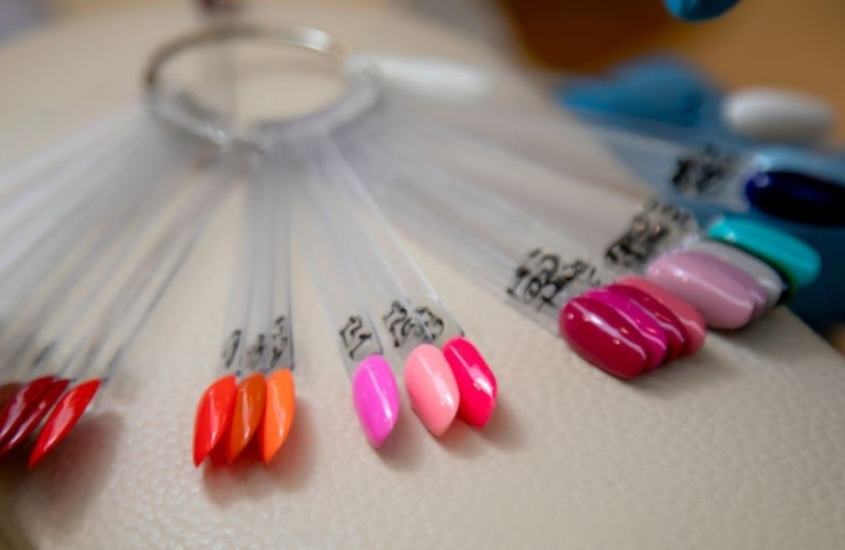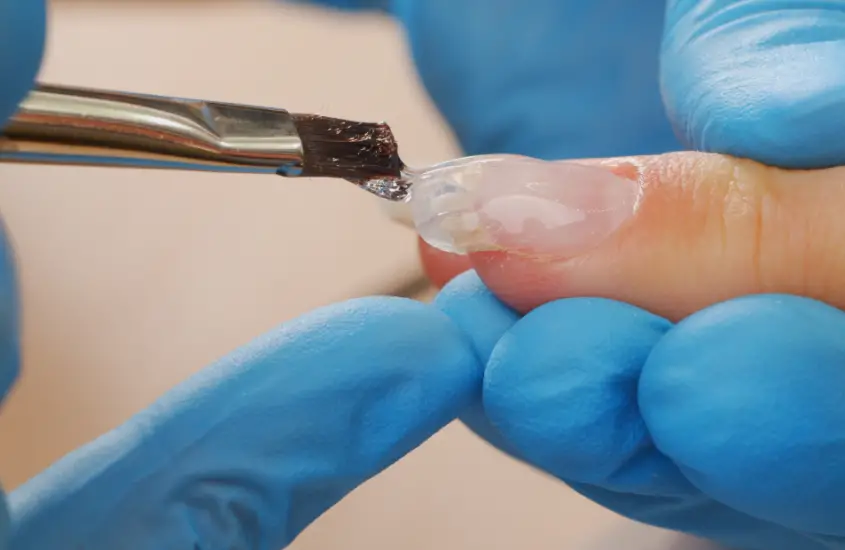How Thick Should Acrylic Nails Be?

Are you a fan of attention-grabbing, statement-making nails? Acrylic nails are becoming increasingly popular as a result of their versatility and ability to transform natural nails into works of art. However, one important factor that is frequently overlooked is the thickness of acrylic nails. A question arises about how thick acrylic nails should be. The right thickness can make or break achieving the desired look and ensuring long-term durability.
We will delve into the world of acrylic nail thickness in this comprehensive guide. We’ll look at why it matters, what factors to consider when determining the ideal thickness, and practical advice for getting the perfect width. This article is for you if you are a nail enthusiast, a professional nail technician, or simply curious about the science behind stunning acrylic nails. Prepare to learn the secrets to flawless acrylic nails by understanding the significance of thickness.
I. Why Does Nail Thickness Matter?
Acrylic nail thickness is important for both their overall appearance and durability. Here’s why nail thickness is important:
A. Appearance:
The thickness of acrylic nails has a direct impact on their aesthetic appeal. Whether you want a natural, subtle look or bold, dramatic designs, the thickness is critical. Choosing nails that are too thick can result in an unnatural, bulky appearance, while choosing nails that are too thin may result in a lack of impact. Finding the right thickness for your acrylic nails ensures that they complement your style and enhance the beauty of your hands.
B. Durability:
Acrylic nails should be able to withstand daily activities as well as look good. The thickness of your nails is proportional to their strength and resilience. Thicker nails are more durable and less likely to break or chip. Overly thin nails, on the other hand, may be more fragile and prone to damage. By achieving the proper thickness, you can ensure that your acrylic nails remain intact and flawless for an extended period of time.
C. Comfort:
The thickness of the nails also contributes to the ease of wearing acrylic nails. Excessively thick nails can feel heavy and uncomfortable on your natural nails. Nails that are too thin, on the other hand, may lack stability and feel weak or flimsy. The right thickness balance allows for a comfortable and enjoyable experience while wearing acrylic nails.
Nail thickness is important because it has a direct impact on the overall appearance, durability, and comfort of acrylic nails. You can achieve stunning, long-lasting nails that make a statement while also ensuring a comfortable and enjoyable experience by striking the right balance.
II. Factors to Consider for Acrylic Nail Thickness
Several factors must be considered when determining the ideal thickness for your acrylic nails. To achieve the ideal balance, consider the following factors:
A. Natural Nail Length:
The length of your natural nails is an important consideration. If your nails are shorter, a thinner acrylic overlay can help you maintain a more natural appearance. If your natural nails are longer, a slightly thicker acrylic layer can provide the required support and strength.
B. Desired Look:
The thickness of your acrylic nails should be guided by your desired look and style preferences. A thinner layer of acrylic is usually recommended for a more natural and understated look. A slightly thicker acrylic layer, on the other hand, can provide a solid canvas for intricate nail art and embellishments if you’re going for bold and eye-catching designs.
C. Lifestyle:
When deciding on nail thickness, consider your lifestyle and daily activities. If you live an active lifestyle or perform tasks that may cause stress on your nails, choosing a thicker layer can provide added durability and protection. If you lead a more sedentary lifestyle, a thinner layer may be sufficient.
D. Nail Shape:
Your nails’ shape can also influence the ideal acrylic nail thickness. If you prefer a square, for example, a slightly thicker acrylic layer can help maintain the desired sharp edges. A thinner acrylic layer can achieve a more natural and seamless look on rounded or almond-shaped nails.
E. Personal Comfort:
Finally, your personal comfort is an important factor in determining acrylic nail thickness. Some people prefer the feel of thinner nails, while others prefer the security of a thicker layer. Pay attention to your preferences and select a thickness that makes you feel confident and comfortable.
You can make an informed decision about the thickness of your acrylic nails by taking these factors into account: natural nail length, desired look, lifestyle, nail shape, and personal comfort. Remember that the goal is to strike a balance that complements your style, withstands daily activities, and provides a comfortable and enjoyable experience.
III. How thick should acrylic nails be?
Determining how thick should acrylic nails be? The precise thickness for acrylic nails can vary depending on individual preferences and desired styles. However, here are some general guidelines to help you find the optimal thickness range for your acrylic nails:
1. Natural and Subtle Appearance:
A thinner acrylic layer will give you a more natural and understated appearance. The ideal thickness for this style is typically between 0.5mm and 1mm. This thickness adds strength and durability to your natural nails while providing a delicate overlay.
2. Classic and Versatile Style:
A thickness between 1mm and 1.5mm is frequently advised for a classic and versatile acrylic nail style that allows for various designs. This collection strikes a balance between a natural look and a strong foundation for nail art or embellishments.
3. Bold and Dramatic Designs:
A slightly thicker acrylic layer can provide the necessary support for bold, dramatic nail designs or longer nail lengths. In these cases, a thickness of 1.5mm to 2mm is frequently sufficient. This range provides the necessary strength and stability for intricate designs or long nail lengths.
Remember that these are only guidelines, and personal preferences play a significant role in determining acrylic nail thickness. Some people prefer thinner nails for a more natural look, while others prefer a thicker layer for added durability. To achieve the desired results, it is critical to communicate your preferences with your nail technician.
IV. Tips for Achieving the Right Nail Thickness
Achieving the desired acrylic nail thickness requires attention to detail and careful execution. Consider the following tips to help you achieve the perfect nail thickness:
1. Nail Preparation:
Proper nail preparation is crucial for achieving the right thickness. Start by cleaning your natural nails and removing any old polish or oils. Gently file the surface of your nails to create a rough texture, allowing the acrylic product to adhere better.
2. Professional Consultation:
If you’re new to acrylic nails or aren’t sure what thickness is best for you, it’s best to consult a professional nail technician. They have the knowledge and experience to evaluate your natural nails, discuss your desired style, and recommend the appropriate thickness for your preferences and lifestyle.
3. Product Selection:
Select reputable brands of high-quality acrylic products. Choose acrylic powders and liquids designed specifically for overlays and extensions. These products are intended to provide the appropriate consistency and thickness for the best results.
4. Nail Forms and Tips:
Nail forms serve as a template for sculpting the acrylic overlay, allowing you to more precisely control the thickness. Tips, on the other hand, are available in a variety of thicknesses and can be used as extensions prior to applying the acrylic overlay.
5. Controlled Application:
It is critical to maintain control over the thickness of the acrylic product when applying it. Begin by applying a thin layer of acrylic near the cuticle and gradually increasing the thickness towards the free edge of the nail. This technique creates a natural gradient and keeps the nails from looking too thick or bulky.
6. Nail Shaping and Filing:
Once the acrylic has fully cured, shape and refine the thickness of the nails with a fine-grit file. File the sidewalls and free edge gently, keeping the desired shape while ensuring a smooth, even thickness throughout.
7. Regular Maintenance:
Maintaining the desired thickness requires regular nail maintenance. Schedule regular fills or infills with your nail technician so they can adjust the thickness as needed and keep your acrylic nails in good condition.
You can get the right thickness for your acrylic nails by following these tips. Remember that practice and patience are essential. With practice, you’ll gain a better understanding of your preferences and techniques for achieving the ideal nail thickness that complements your style and improves your overall nail appearance.
Conclusion
How thick should acrylic nails be? Determining the proper acrylic nail thickness is critical for beautiful and long-lasting results. To determine the ideal thickness range, consider factors such as natural nail length, desired look, and lifestyle. The thickness of your nails has a direct impact on their appearance, durability, and comfort. There is an ideal thickness for you whether you prefer a natural, classic, or bold style. Use practical advice such as proper nail preparation, product selection, and professional consultations. Regular maintenance and shaping are required to keep the desired thickness. Finding the right thickness is a personal journey, so seek advice from a nail technician. Accept the art of acrylic nails and enjoy stunning, long-lasting, and comfortable nails that leave a lasting impression. With this knowledge, you can confidently explore the world of acrylic nails and elevate your game.








